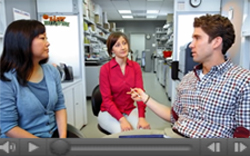UPDATE: The slides from the MIRA ESI Funding Opportunity Webinar have been posted.
NIGMS recently reissued the funding opportunity announcement (FOA) for the Maximizing Investigators’ Research Award (MIRA) program for Early Stage Investigators. The first application due date is October 3, 2017. As in previous years, the purpose of this MIRA mechanism is to provide support for the program of research in the laboratory of an early stage investigator (ESI) that falls within the mission of NIGMS. Here are some important points to know if you’re considering applying to this FOA:
- To be eligible, you must have completed your terminal research degree (or medical residency) less than 10 years ago and must not have served as the principal investigator (PI) of a substantial NIH research award, e.g., an R01, P01, U01, SC1 or DP2. If you’ve served as the PI of one or more smaller awards, such as an R00, R03, R15, R21, SC2 or SC3, you retain your ESI status and can still apply to the ESI MIRA program. A complete list of the smaller grants and awards that do not affect ESI status is available on the Office of Extramural Research webpage.
- ESI status can be extended for qualifying reasons, including but not limited to family care responsibilities or active military service. Here’s a complete list of qualifying reasons.
- If you submitted a MIRA application in previous years and are still eligible for this FOA (i.e., retain ESI status), you’re welcome to apply but must submit a new application rather than a resubmission. A new application may still cover the same topics you proposed previously, but must not include any specific section explicitly designated as a response to reviewers.
- If offered a MIRA, you must devote at least 51% of your time available for research to the award; however, note that taking less than 51% salary for the PI is allowed and in no case should more than 51% be requested.
- Unlike previous rounds, you may have an NIGMS R01 application and a MIRA application under review at the same time. Should both applications score well enough to be considered for funding, you will be required to withdraw one or the other.
- Applications that don’t fall within NIGMS’ mission will be returned without review, so be sure to contact me or the program director whose scientific area is closest to yours to discuss your proposal while in the planning stages!
These and many other topics related to the MIRA ESI FOA are covered in detail in a newly-released set of frequently asked questions.
We’ll also be hosting a webinar to discuss the FOA (no longer available) and answer your specific questions about the program on Monday, July 10, from 1:30-2:30 p.m. EDT. The site is compatible with mobile devices. For an audio-only presentation, call 1-888-989-5313 and enter passcode 8866047. We plan to post the archived webinar and slides on the MIRA webpage after the event.
NIH Staff Participating in July 10 Webinar
Jon Lorsch, Institute Director
Kristine Willis, Program Director
Brian Pike, Scientific Review Officer
Lisa Moeller, Grants Management Officer


